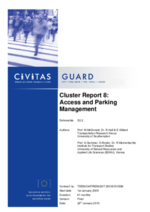Parking management strategies
Summary
The measure focused on the definition and implementation of a parking management strategy involving differentiated fees, marketing and restriction enforcement in order to modify parking habits in mainland Venice and thus reduce congestion and air pollution.
Implementing sustainable mobility
Growing car use in and around mainland Venice has led to accessibility problems and congestion. The high percentage of short-term parking (between 0 and 4 hours) has contributed to parking problems in the centre of Mestre. In response, park and ride facilities were set up at public transport interchanges on the outskirts of Mestre.
The City of Venice installed real-time information panels indicating available parking spaces in the park and ride facilities and introduced differentiated parking fees aimed at discouraging parking in the city centre.
At the beginning of the MOBILIS project, two park and ride facilities were located at the access points to the mainland urban area. Surveys carried out between 2002 and 2003 highlighted that appropriate regulation of the parking system could contribute to the management of peak-hour traffic flow and improve conditions for pedestrians and cyclists.
In order to encourage the use of park and ride facilities and reduce the number of cars arriving in the city centre, in autumn 2004 the City of Venice planned to modify the Mestre parking tariff system by introducing three levels of parking charges, which decrease in relation to distance from the city centre. The on-street parking fee system in the centre of Mestre is known as “blue lanes”.
The measure objectives were to:
- define and implement a parking management strategy involving differentiated parking pricing, parking marketing and restriction enforcement; and
- modify private car parking habits in the mainland in order to reduce congestion and air pollution.
Progress
In 2005, the public traffic offices monitored the use of different types of parking spaces in the city centre and in the suburbs. The results were used to create a map of parking supply and demand in mainland Venice and to set the new parking price strategy.
Suitable differentiated tariffs were identified, as well as areas where the “blue lanes” pricing system should be applied to encourage the use of remote parking facilities. The City Council approved the tariffs and parking regulations in May 2007 and the municipal police and officers of the mobility service company ASM began to enforce the regulations.
Between the end of 2004 and 2007, the supply of parking areas around the centre significantly increased: 10 new park and ride facilities opened, offering around 2,400 parking spaces, and plans were made for further facilities. The park and ride sites are linked to the city centre by frequent public transport services and minibus services. An information campaign was launched to inform citizens and commuters about the facilities and a map of interchange car parks and alternative mobility options (car sharing, electric vehicles and bicycle rentals) was produced. Variable message signs were installed in September 2008 to promote the use of park and ride facilities, indicating car park names and the number of available spaces.
Outcomes
Over the period 2004 to 2008, the use of park and ride facilities in mainland Venice mainland shot up; the overall number of parked vehicles in the whole park and ride system increased by around 309 percent, from 51,990 in 2004 to 212,979 at the end of 2007. The same trend can be observed for the average number of vehicles per day: the increase is particularly relevant for the best-located car parks and those with the best public transport access. Higher prices in the city centre prompted commuters and visitors to use the park and ride facilities on the outskirts of Mestre and limited long-stay parking in the city centre.









